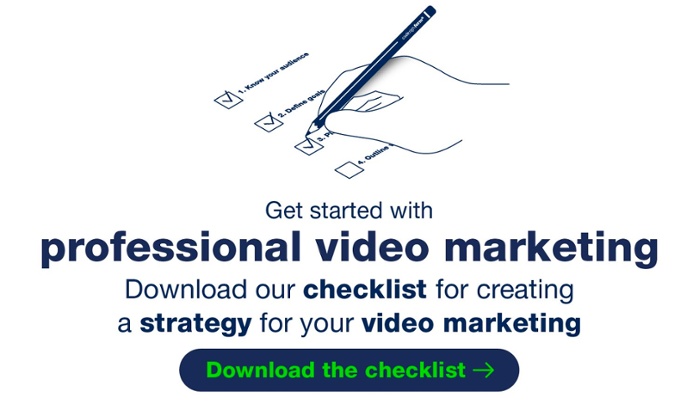Over the last decade savvy marketers have realized the growing importance of incorporating video as part of a marketing mix. In fact, in 2020, over 90% of marketers say that they will be using videos as a main component of their marketing strategy.
Here's what our head of film and animation say's about getting started with a video marketing.
As a business owner or manager, it is important that you also recognize the importance of video marketing and the benefits it yields, such as increased brand recognition, a better edge against competitors, and a stronger ROI. Written content and an aesthetically pleasing website are no longer enough to grow and maintain a share of the target demographic in today’s competitive online marketplace.
Free checklist: Download our 7 step checklist for creating a video marketing strategy
But just knowing that videos are important isn’t enough either. You’ve got to know how to build a video marketing strategy, and that’s something that not even a lot of marketers know how to do effectively.
To ensure optimal benefit from your video marketing, it’s recommended that you work with an agency that specializes in or at least can showcase a great amount of experience in video marketing. You can also follow the steps in this video strategy guide to help build and launch your video marketing strategy in an efficient, organized manner.
7 Steps to an effective Video marketing Strategy
Know your audience- Define goals
- Plan content
- Outline video plan
- Consider your video budget
- Optimize and publish your video(s)
- Track and test
1. Know your audience
In order to produce videos that will resonate with your audience, you must first know your audience. If you haven’t already amassed ample research on your target demographic, it’s definitely time to start. Go even more in-depth and determine what criteria will form your ideal buyer persona. Having this critical information at hand will help you move forward into developing content, as well as knowing where it will yield the most views from your intended audience.
2. Define your goals
What do you hope to achieve from your video marketing strategy? Are you attempting simply to increase sales? Are you seeking to drive more traffic to your site? Is your intention to increase brand awareness? Note that you don’t necessarily need to decide on a single goal. Your video marketing strategy can attempt to achieve all of the above and more. Quite often this will mean developing more than one video, and that’s quite all right too. Sometimes attempting to cram too much into one video leaves the viewer confused or disinterested. Specify each goal you are trying to reach, and plan video content accordingly.
You might also like: "Why (professional) video marketing is so powerful"
3. Plan your content
All your video content, whether it’s a product film, a testimonial, a social media video, an expert interview, etc., should speak directly to your buyer persona, which is why you need to consider the different styles of video very carefully. Videos play a very large role in the consumer’s decision-making process. Nearly 85% of consumers said they’ve purchased a product or service after watching a brand’s video. But that statistic will only hold true for you if you develop content that is specifically geared toward your audience.
Consider the tone and voice of your video content, the story the video will tell, what questions it will answer, and what you will expect from the viewer (your call-to-action). Meet the consumer’s expectations with your video content by offering them something they value, and you’ll increase your chances for a successful ROI every time.
You might also like: "11 different styles of video that promote your products professionally"
4. Outline your video plan
This is the step where you will be to plan the content for each video that will be incorporated into your video marketing strategy. For example, you may want to produce a corporate film to increase brand awareness, a social media video to drive traffic and grow your audience, and a product video to showcase a new product or service.
Create your proposed topics for each video, outline the content, and consider how long you’d like each video to be. An agency specializing in video marketing can aid you in this project. Some types of videos work best at a certain length, and some benefit from a specific call-to-action. Additionally, planning where to publish your videos is also a key consideration.
5. Consider your budget
Now that you have a good idea in mind of what you’d like to do, you’ve got to figure out how much it will cost. While today’s technology makes it easy for nearly anyone to record and publish a video with ease, your business will benefit more from professional-looking content, especially in the case of brand videos, behind-the-scenes videos, and many other types of video content. Remember, your competitors are likely working on a video marketing strategy too, and if their content looks professional and yours appears noticeably amateurish, guess which one the audience will remember and respond to?
Be realistic with your budget. You may have grand visions of what you want to do in your marketing videos, but if the budget doesn’t support that, you’ll need to adjust your plan. Will you be shooting your videos in-house or retaining the services of a professional video marketing company? What is worth the expenditure and what areas or resources can you cut? Take the time to research different options — this will not only give you a good idea of the average costs of making certain types of videos, but also make you aware of what resources and professional services are available to you.
After all, as much as you might consider yourself a jack-of-all-trades, if you aren’t equipped or experienced enough to take on the development of a professional video yourself, it’s best left to the experts. You’ll be thankful later when you view your beautifully and professionally produced video for the first time.
6. Optimize and publish your videos
The best part of your video marketing strategy — publishing them! There are a multitude of marketing channels and platforms to utilize to showcase your videos, but only certain types of videos will do well on certain channels. Once again, this comes down to knowing your audience, what they want to see, and where they are most likely to see it.
But in addition to publishing your videos, you’ll also want to optimize them. This means utilizing keywords in the descriptions, video titles, meta tags, adding captions, and occasionally refining the videos based on initial feedback. The better you optimize your videos, the greater the chance of your audience not only finding and viewing your videos, but also engaging with them, which consequently results in increased brand recognition and strong click conversions.
You might also like: "Video marketing statistics 2020"
7. Track and test
Your video marketing strategy doesn’t end once the videos are published. You’ll want to use analytical tools and other means to track your results and tally your views. There are a number of factors that come into play to determine the ultimate outcome of your video marketing strategy. From the message in your videos to the time of day it was posted to the keywords you’ve used to the overall length of each video.
To that end, it’s recommended that you engage in some A/B testing in order to better determine what works and what doesn’t. This will give you great insight into your audience, the effectiveness of your videos, and which content is more likely to deliver the results you want.
Some of the key metrics you’ll want to track include:
- Total Views — A view is counted as someone simply beginning to watch your video, but not necessarily finishing. Views are measured differently on different social media platforms and marketing channels, so you’ll want to be aware of the specifics for each channel you are using in order to get a better idea of how your video is performing.
- Play Rate — This metric measures the number of times someone actually intended to play the video by actively clicking the play button.
- Play Length — This will tell you whether viewers watched your complete video or skipped some, an indicator that your video may either be not engaging enough or too long.
- Click-through Rate
- Click Conversion Rate
- Social Media Engagement Metrics such as Likes, Comments, Shares, and Retweets.
Using the above information, you’ll also be better equipped to improve upon your video marketing strategy in the future and garner a much stronger ROI.
In conclusion
Building a strong video marketing strategy takes a lot of time, brainstorming, and effort. It isn’t necessarily something that can be completed in a few days, or even a few weeks time depending upon the scope of your strategy. But with the aid of a professional video marketing company, you can rest assured that not only will your videos look professional, but you’ll have help, guidance, and the resources you need every step of the way to ensure your video content performs at its best and helps you achieve your goals.
















